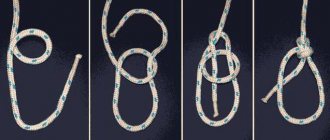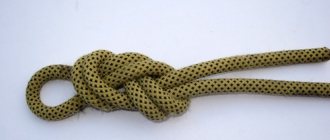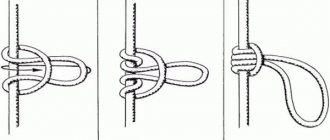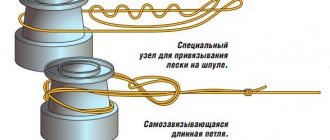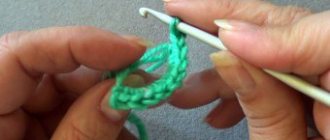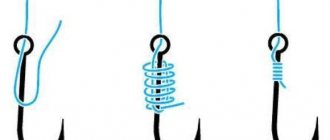Knitting pattern for the gazebo knot
Thanks to its distribution and thousand-year history, the “gazebo knot” has received several methods of knitting. They differ only in the order and features of the actions when tying and do not in any way affect its strength or effectiveness. For better understanding, the most common, classic method is proposed below.
Classic way
| We take a rope with one free end, you can wrap it through a support to which the rope will be tied; We make a simple small loop, without turns; |
| Now we pull the free end through a small loop, which needs to be supported with your fingers; We wrap the running end behind the free part of the rope and insert it again into the small loop; |
| Now we tighten the knot by the large loop on one side and the free part on the other (using the free end you can adjust the width of the large loop); We managed to tie a “bowline” or “arbor knot” in our classic version! |
The “Bouline Knot” is unique in its characteristics. Externally, it may resemble a weaving knot, but everything differs in the way it is tied. Such a knot never gets pulled into a dead center under the weight, it does not damage the rope or cable under the weight, it is quite easy to tie and never unties itself. Basically, it plays the role of securing the safety rope on a person who is sitting on the gazebo.
Knitting with one hand
| Take the running end in your fist |
| Stick your thumb out and wrap the main cable |
| Turn the brush to create a loop on the main cable |
| Push your hand into the loop along with the running end |
| Wrap the running end around the main cable on the reverse side |
| Intercept the running end and pull it back into the loop |
| Tighten the knot by pulling the running end and the main part of the rope |
It’s so easy to tie a Bowline knot with one hand, you can see it more clearly in the video:
“Bowline” is applicable to all main types of cables and ropes, regardless of the quality and characteristics of the fiber. It helps out when you need to temporarily tie and shorten the length of a rope or cable, as well as when you need to play it safe and release the frayed part of the rope or cable from tension. The “Gazebo Knot” enjoys great respect among sailors, since over its centuries-old history it has saved many lives of sailors.
Double bowline
WikiReading
Marine knots in everyday use Jarman Colin
Double bowline
This is a good way to make a loop in the middle of a rope or to quickly make a rope rescue cradle. It's not very comfortable to sit in, but it can save you if necessary.
To tie a Double Bowline, make a coil on the cable, bring it to the main part and twist it as you usually do with this type of knot. As a result, a rope is inserted into the protruding eye, which is pushed onto the main part and remains there. The resulting knot looks like a Double Knot, but without the normal rope end inside the loop.
Rolling onto the side ball with double rolling from Mengo Balls “10” and “15” are located near the corner pocket, “eight” is in the opening of the corner pocket. It is necessary to put all three balls into the pocket with one roll-up shot. Rolling onto the side ball with double rolling from Mengo For successful
McCleery's Double Roll Bead Ball Roll
McCleary's Double Roll Bead Ball The Four, Seven and Twelve are placed along the short side near the corner pocket. In order to play the “twelfth” into the pocket, it is necessary to strike the cue ball with a strong left side kick. IN
Double carom in motion
Double carom in motion To perform this trick, you need to hit the white in such a way as to drive the red into the upper left corner. After this, you need to direct the white ball along the sides of the table so that, having reflected from them three times, it would go to the corner and
Kato Danzo - double spy
Kato Danzo - double spy In the history of Japanese espionage art, there was, perhaps, not a single ninja whose name was surrounded by a greater aura of mystery and mysticism than Kato Danzo. His outlandish skill was so incredible that people called him a magician,
Double (simultaneous) punch with both hands
Double (simultaneous) strike with fists of both hands. The opponent grabbed you by the hair with his left hand. Take a step forward with your right foot behind the opponent’s left leg. At the same time, deliver a direct blow to the chin with the fist of your left hand and a blow from below with the fist of your right hand to the torso
Bowline, or gazebo knot
Bowline, or Arbor Knot Perhaps this is one of the most necessary and used knots on a ship, it is a fixed loop at the end of a rope (3). Easy to tie, it is also easy to untie, even if it was previously under great pressure. There are many
Double clew and Double clew
Double Clew and Double Sling Knot Double Clew Knot For added safety, the Clew and Sling Knots (see previous page) can be quickly converted into double clew knots. This is done like this: you wrap the working end of the rope around
Spanish Bowline (Gazebo Knot)
Spanish Bowline (Gazebo Knot) The Spanish Bowline, like the Double Bowline, consists of two loops that make it possible to use it as a replacement for a rope cradle or, if possible, for lifting aboard a ladder. The design of the Spanish Bowline is not
Double punch
Double strike In conclusion, I would like to cite one of the last serious games I played. In 1953, in the chess championship of universities in the capital, I led the team of Moscow State University (where I work as a senior lecturer in the department of physics
Tying the “Running Bowline” knot and its application
This type belongs to the simple type of sliding rope knots; it is used in maritime affairs for searching for sunken objects, catching driftwood, boards, logs, and lifting anchors.
To tie it, you need to follow these steps:
- Take a rope (it is necessary that it has a slippery surface, since the operation of the knot involves changing the size of the loop). A small loop is made 50-60 cm from the end.
- The end is wrapped around the main rope, forming a large loop.
- Next, the end is threaded into a small loop.
- Wrap around the root end of the large loop and pass back into the small loop (similar to a classic bowline)
- The resulting knot fixes the formed main loop. The size of the large loop can be changed in diameter.
This knot is very strong; it can be tied in a few seconds and quickly untied.
Basic maritime knots and their application
Before you take the helm and work with the sails, you need to learn how to tie sea knots. This is where practical yachting training begins. On board, every little detail matters. Even the way you fold a coil of rope into a coil and hang it to dry.
There are two basic terms to remember so you can follow the instructions.
The root end is the part of the rope that remains motionless.
The running end is the part of the rope that remains free and is actively used in work.
Unusual sea knots with the names “cat’s paws”, “thief’s”, “snake”, “leg of lamb”, “crab loop”, “monkey chain”, “drunk”, “oyster” arouse great curiosity. You can read more about them, for example, in Lev Scriabin’s book “Sea Knots”. For sailing beginners, to begin with, it is enough to know which main sea knots are used most often.
Eight
Classic. The name reflects the form. This sailor's knot can be tied effortlessly even if the rope is wet. On a sailing yacht, the figure eight knot is commonly used as a stopper and anchorage. Using a figure eight, you can make handles for a bucket or ties for a sled, tighten the strings of a guitar, or make a dog leash more comfortable.
How to tie a figure eight knot:
- Create a loop. To do this, wrap the running end around the main one, and then pull the end out from above.
- Bring the running end behind you and thread it through the loop.
- Tighten.
What is a "Reverse Bowline"?
Despite its high reliability, the classic Bowline knot often breaks and drops a load whose weight exceeds 80 kg, especially if the tying was done by an inexperienced person. The “Reverse Bowline” modification has greater strength: in this case, after creating the first loop, the second one is inserted into it not from the side of the loaded rope end, but from the reverse side.
The peculiarity of such a knot is that the loaded end will not be pinched by the loop, and the load at the inflection point leading to rupture is much less. One of the loops creates two points of application of force, due to which the weight is applied more evenly to the rope. Thanks to this principle, the “Reverse Bowline” is considered more tensile.
How to knit a Double Bowline?
Such a knot, which involves the formation of two non-tightening loops, is used when it is necessary to lift a person to a certain height, and it is also used as part of compliance with safety regulations when working at height.
For knitting, one loop is made half the size of the second: in the larger loop a person can sit, and the second serves to grab the body under the arms. This design makes it possible to use both hands for work, which is why this knot is especially popular among industrial climbers.
In addition, the “Double Bowline” can be used to knit a safety rope: in this case, the length of both loops is the same.
Method of knitting Double Bowline:
| When knitting, you must use a cord or rope folded in half; after inserting the large loop into the small one, the end is slightly pulled out. |
| With the end, circle the large loop and pass it to the upper segment of the knot. |
| Hold the main rope with one hand and pull the left side of the large loop with the other to tighten the Double Bowline. |
How to tie a bowline around a support?
We make a cross turn on the main rope
Pass a sufficiently long end of rope through the ring, around a post or support. In the illustration it runs on the other side of the pillar; the direction doesn't matter.
Make a cross turn on the root part of the rope. To do it correctly, the easiest way is to hold the root part in your left hand, the back of your hand facing up, your thumb closer to your torso. Now turn your wrist away from you so that your hand is palm facing up.
We pass the bend into the loop
Make a bend at the root part and pass it into the newly formed loop.
We pass the running end of the rope through the bend
Take the running end, pass it through the bend of the root part and hold loosely.
Pull the root part and straighten the knot
Pull the root part and the knot will tighten; you will have the perfect bowline. It will be more effective not to pull evenly on the root part, but to jerk it sharply. Sometimes at this stage not everything goes smoothly, and it can be useful to run your fingers over the knot to give it the correct shape.
Using the running end, tie a control knot around the side of the loop where it came from. This will make your knot reliable, preventing possible self-loosening under varying loads.
Application of the Gazebo Knot
This knot is used to tie a rope or cable to a board in a ship's gazebo. Another name “bowline” comes from the English “The Bowline Knol” where “bowline” means a device for pulling the luff of the lower sail. This device is attached to the luff using a marine bowline knot.
The gazebo unit is very actively used in the navy. Due to its versatility and characteristics, it can be used for a wide variety of purposes on a ship. In addition, its use can often be found in construction, extreme tourism and mountaineering, and household activities.
The gazebo knot migrated from the fleet to other spheres of human activity in ancient times. Through thousands of years of its history, it has not lost its relevance to this day. Its big advantage is that it is excellent for knitting on absolutely any type of rope. The bowline can be knitted on a support, in a tense or relaxed state. Thanks to this feature, it has received quite a wide application, unlike an ordinary sea knot.
Bowline knot
Application of Bowline
People unfamiliar with nautical terminology may think that the name “gazebo” comes from the verb “to chat” or from the noun “gazebo.” In our maritime language, the name of this unit comes from the “gazebo”, but not from the usual one, but from a sea gazebo, which is a small wooden board - a platform used to lift a person onto the mast or lower it over the side of the vessel during painting or other work. This board is attached with the help of cables to the lifting cable with a special knot, which is called the gazebo knot. Its second name is bowline. It comes from the English term “bowline,” which refers to the tackle used to pull back the pointed side luff of the lower straight sail. This tackle is tied to the luff of the sail with a “Bowline Knol”, or simply “Bowline”.
It makes sense to dwell on this point in more detail. Indeed, it is admired by those who deal with cables and knot tying. This is one of the oldest and most amazing knots ever invented by man. Archaeologists testify that the gazebo knot was known to the ancient Egyptians and Phoenicians 3000 years BC. In English marine technical literature it is often called the “king of knols”. Not every sea knot can compare with it in the number of positive properties it possesses. Taking into account the scope of its application and excellent qualities, the gazebo knot is rightfully awarded the royal title in the huge dynasty of maritime and non-marine knots. In appearance, it is similar to a weaving knot, but its running end does not go into the loop of the other end, but into the loop of its root end.
In an ancient maritime treatise this knot is described as follows:
“This useful loop knot has been known since ancient times. It is knitted by forming a hose on the rope and passing the free end through it - up and down, pulled under the main trunk of the rope or rope. Take the lapar in your left hand so that its free end is directed away from the face of the knotter. At a certain distance from the lapar, depending on the size of the loop you need to obtain, a peg is made, i.e. point. If you look forward, the peg should be on the right side of the lapar. holding the peg with the index finger and thumb of the left hand, the free (running) end of the lapar is passed into it so that it is directed towards the person working with the knot and goes into the binding (cove) with the point and the root part of the lapar. Having circled the undercarriage of the Lapp around the main one, it is passed back into the point, leading along itself. after that, tighten the point and the running end of the lappet tightly.”
The Bowline knot, despite its amazing compactness, simultaneously contains elements of a simple knot, a half-bayonet knot, a weaving knot and a straight knot. The elements of all these knots in a certain combination give the Bowline knot the right to be called universal. It is surprisingly easy to knit, even with strong traction it never tightens “tightly”, does not spoil the cable, never slides along the cable, does not untie itself, but is easy to untie when needed.
The main purpose of the bowline knot is to tie a rope around a person under the arms as a means of insurance when climbing to a height, falling overboard or in a smoky room during a fire on board a ship. A gazebo can be inserted into the non-tightening loop of this knot.
A loop tied in a bowline knot on the mooring line reliably serves as a firelight. This knot can be successfully used for tying two cables of any diameter or for tying a thick plant cable with a steel one (in this case, the cables are connected with loops, and the knots are tied at their root ends).
Of all the ways to connect two cables made of different materials (for example, hemp and steel, Dacron and manila), connecting with two Bowline loops will be the most reliable. In addition, a bowline knot can be used to make a reliable tightening loop. It can be used for mooring and for attaching the cable to the hook.
A bowline can also be safely used to temporarily shorten a cable or in cases where it is necessary to eliminate a worn-out piece of cable from work by tying a knot so that this piece fits into a loop.
In mountaineering, the bowline is used primarily as a tie-down knot. The most common method of tying ropes to supports in industrial mountaineering is a bowline.
